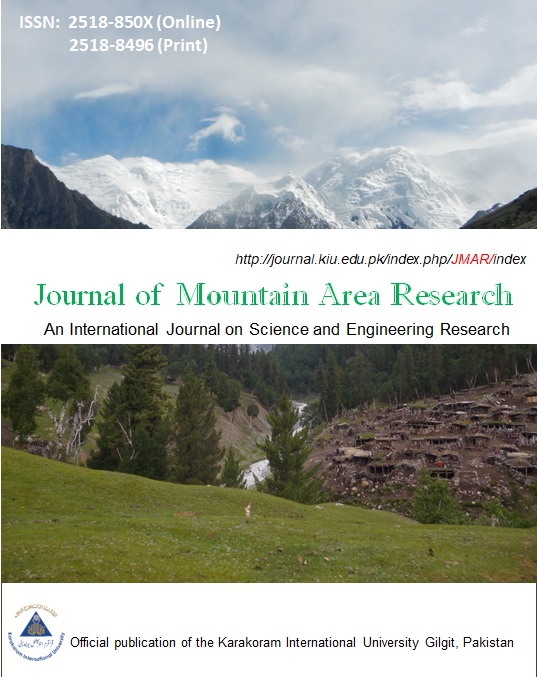OUTCOME AND ROOTS OF EARLY MARRIAGES IN GILGIT-BALTISTAN: A QUANTITATIVE DESCRIPTIVE STUDY
Main Article Content
Abstract
The aim of this study was to find out the causes and outcome of the early marriages in the light of victims and gatekeepers observations. However, one-third of under-aged girls in the developing countries are married before the age of 18 years. Although in Northern areas of Pakistan, early marriage is a very common problem in both gender, especially, in Gilgit-Baltistan and the ratio is higher than any other part of the country. Moreover, in this region, early marriage is prevailed due to traditional customs, religious dominance and supernatural evil. The present study chose two categories, first category for victims which includes respondents of age group from 10 to 40 years old and married before 18 years of age. The second category was chosen for interpretation of the community gatekeepers. We utilized a quantitative survey method to collect data from each district and examined 200 sample. A sample is divided into two groups, the victim's group includes 150 respondents and the group of gatekeepers includes 50 sample size. The tailor-made close-ended questionnaire was designed for the collection of data. Beside this, a Likert scale was also used for Professionals.
There is a need to take some serious steps to eliminate this social disease which promotes the illiteracy, poverty, crime, economic burden, terrorism, domestic violence and rapid increase in population which is surmounting challenges in the pathway of regional development. Early marriage has psychological, physical and economic consequences; most girls remain unable to complete their primary and secondary education and also have the negative impact on their health.
Article Details
Papers accepted for publication become copyright of the Editorial Office, Journal of Mountain Area Research, Karakoram International University Gilgit, Gilgit-15100, Pakistan and authors will be asked to sign a copyright transfer agreement. Articles cannot be published until a signed copyright transfer agreement form has been received.
The work published in this journal is licensed under a Creative Commons Attribution 4.0 International License.
References
[2] United Nation International Children’s Emergency Funds. Ending Child Marriage: Progress and prospects. New York: (2014).
[3] Zia A. Underage married girls from Pakistan. Tribune. January 2, (2013).
[4] Abgeiki, “Coercion to Sex and Marriages in Ancient and Medieval Societiesâ€, Washington D.C., (1993) pg. 85-190.
[5] Retrieved from http://www.icrw.org/files/images/Child-Marriage-Fact-Sheet-By-The- Numbers.pdf Accessed at 27th May 2017)
[6] S.M. Mathur, A. Greene, and Malthora. Too Young Too Wed The Lives, Rights, and Health of Young Married Girls. ICRW. (2003).
[7] A.S. Erulkar, T. Mekbib, N. Simie, and T. Gulema. “The experience of adolescence in rural Amhara region, Ethiopia.†Accra: Population Council. (2004) 1-24.
[8] Kyari, Gimba Victor. And Ayodele, Joseph. “The Socio-Economic Effect of Early Marriage in North Western Nigeriaâ€, 5th, (2014), pg. 582 29.
[9] Retrieved from http://www.unicef.org/mdg/maternal.html Accessed on Aug 10th, 2017.
[10] Clarks, Bracej, Dude, “Protecting Young Womenâ€, International Family Planning, Column 32: June (2016) 79:88
[11] Staff Reporter. Pakistan: WHO Report. The Daily Express. Ed., Dated on May 22nd, (2016). Karachi.
[12] UNICEF, “Young People and HIV/ Aids: Opportunity in Risesâ€, A Joint report by UNICEF, UNAIDS, WHO. (2002).
[13] S. Asfaha, Independent Evolution Report. CAMFED and CAMA. Programs, Zimbabwe 1993-2003. (2003).
[14] M. Nasrullah, R. Zakar, A. Kramer: Effect of child marriage on use of maternal health care services in Pakistan. Obstet Gynecol 122: (2013) 517-524.
[15] Haider, Murtaza. Dated on Sep 7th, 2011. Retrieved from http://www.dawn.com/news/657239/bartered-in-marriage-the-bride- exchange-in-rural-pakistan Accessed at Sep 17th, 2017.
[16] M. Nasrullah, R. Zakar, M.Z. Zakar, A. Kramer: Girl-child marriage and its association with morbidity and mortality of children under 5 years of age in a nationally-representative sample of Pakistan. J Pediatr, 164: (2014) 639-646.
[17] Unicef, Multiple Indicator Cluster Survey 2016-17: Gigit-Baltistan. The government of Gilgit-Baltistan (2017) 205-207.
[18] R. Abdul, J. Luan and H. Imran. The province-wide literacy rate in Pakistan and its impact on the conomy, Pacific science review B: Humanities and social sciences Vol 1(3) (2015) 140-144.
[19] S. Mir, “Underage, under law: G-B Lawmakers Blocks Bill to ban Child Marriagesâ€, The Express Tribune. Dec 9th, (2015).
[20] The Nation, Suicide incidents in Gilgit-Baltistan have reached an alarming level June 21, (2017) Retrieved from http://nation.com.pk/21-Jun-2017/suicide-incidents-in-gb-have-reached-an-alarming-level accessed at Nov 15, 2017.
[21] A. Saif ur Rehman. Early Marriages in Pakistanâ€, Chitral Pakistan, The Chitral Times. April 4th,(2014).
[22] UNFPA. Ending Child Marriage: AGuide for Global Policy action. London: International Planned Parenthood Federation. (2006): 1-32.
[23] M. Nasrullah, R. Zakar, M.Z. Zakar, S. Abbas, R. Safdar, M. Shaukat and A. Kramer. Knowledge and attitude towards child marriages practices among women married as children-a qualitative study in urban slums of Lahore, Pakistan. BMC Public Health, (2014), 14:1148
[24] National Institute of Population Studies (NIPS) [Pakistan] and Macro International Inc. Pakistan Demographic and Health Survey 2006-07. Islamabad, Pakistan: National Institute of Population Studies and Macro International Inc (2008).
[25] S. Baig, and F.H. Siddique, The Role of Prenatal Low Intake and Low Birth Weight among Deceased Infant. Journal of Social Sciences and Humanities, Vol (52)-2 (2013).83-96.
